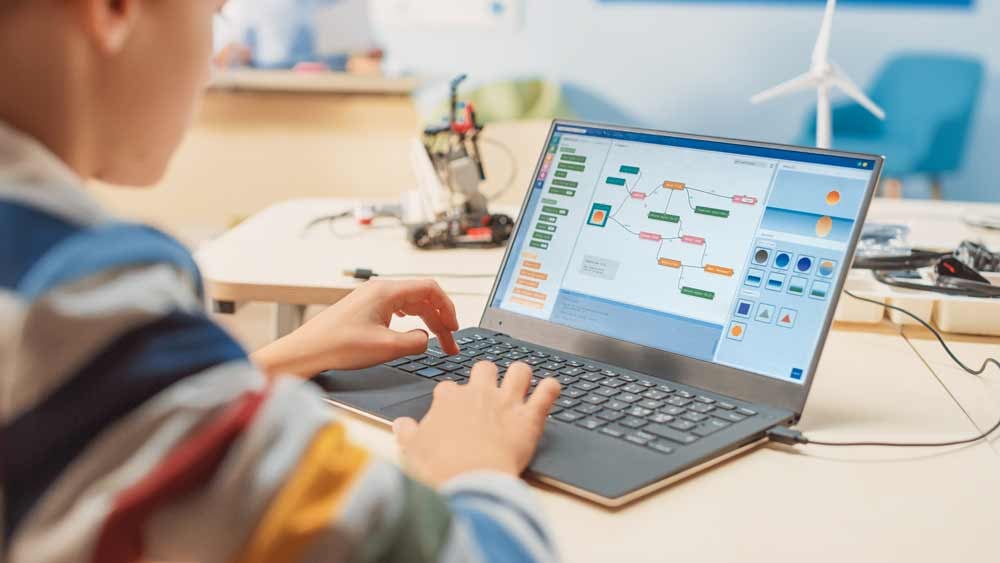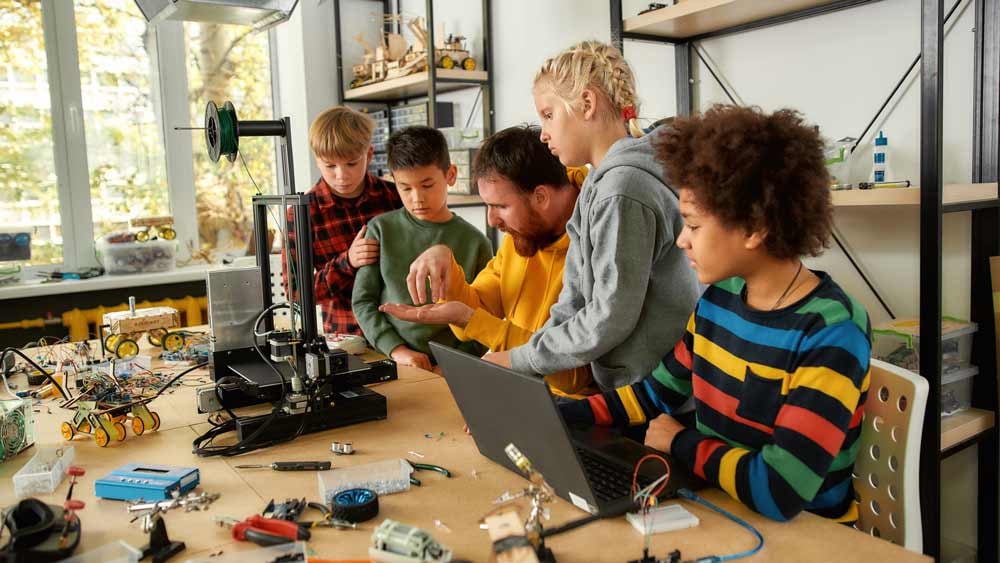
Choosing a cost-effective hands-on STEM program that fits your classroom’s needs and continues to challenge students is difficult. Here are some tips on how to find a STEM Maker Kit that inspires your students throughout the school year.
Introduction
STEM education is best incorporated as both a convergent and divergent learning experience for students. By incorporating hands-on learning, connecting concepts to the real world, and using science, technology, engineering, and mathematics to create things that never existed before, students can practice their STEM knowledge with creativity and experimentation.
It’s an exciting and dynamic environment to learn in, especially for young learners. It’s also a way to encourage their natural creativity to reach new heights through the empowering knowledge and core concepts introduced in STEM subjects.
This makes it all the more necessary to find STEM Maker Kits that can help your students apply the new concepts they’re learning with fun, hands-on activities in the classroom. But searching “STEM Maker Kits” online can provide an array of results that don’t seem to get you any closer to providing the exciting and engaging hands-on learning experiences you’re looking to provide for your students.
Here, we’ve rounded up the facts on STEM Maker Kits, including:
- The benefits of STEM Maker Kits
- How to choose the right kit for your classroom
- Building a STEM Maker Kit lesson plan
- The different types of maker kits available
- How to build a comprehensive STEM curriculum that includes maker kit lessons
Follow along to learn how you can introduce the right STEM maker kit to your classroom.

The Educational Benefits of STEM Maker Kits
STEM education is all about hands-on learning and application in the real world. The roots of engineering itself are embedded in design that solves problems. Maker kits provide students of all ages with experiential learning experiences that apply their creativity to explore new concepts and ideas in a 3-dimensional way.
The benefits from this type of active and engaged learning abound, from building excitement around STEM learning to helping students retain and cement their newly-learned STEM concepts and everything in between. Here are just some of the benefits of STEM Maker Kit projects for young learners:
- Better Retention
Combining convergent and divergent thinking, STEM maker kits provide students the opportunity to physically apply the STEM concepts they’re learning in the classroom through experiential learning experiences and reflect on them through secondary activities. This combination improves retention of core concepts and helps build a solid foundation of STEM fluency.
- Inspired Creativity
Maker kits are a breeding ground for student creativity. Introduce a STEM concept to students and watch them creatively solve problems, develop unique solutions, and design devices of their own imaginations. Within experiential learning, and even with structured lesson plans, STEM maker kits are a proven way to let students’ creativity shine.
- Empower Confident STEM Learners
The hands-on approach of STEM maker kits gives students of all learning styles access to experiment with concepts and build their confidence throughout their STEM journey. Especially for young learners, these fun activities can build excitement and confidence around STEM education and inspire a new generation of empowered STEM leaders.
What Makes a Good STEM Maker Kit?
With the clear benefits of STEM maker kits for the classroom, what makes an effective STEM maker kit, and how do you find the right kit for your students? Here are some features to keep in mind when shopping for STEM Maker Kits.

Age & Grade-Level Appropriate
One of the most common challenges schools face without a comprehensive STEM program in place, is leaving the STEM curriculum to individual educators. Even with the best intentions, it’s easy to develop lesson plans that are too challenging or not challenging enough for students since there is no foundational fluency base established in previous years. When choosing a STEM maker kit for your classroom, be sure to find a kit that is both age and grade-level appropriate.
Clearly Identified STEM Concepts
Building blocks and robotic kits can help students practice their creativity, but a truly effective STEM maker kit should be linked to clearly identified STEM concepts. Intentional design is crucial to helping students familiarize themselves with STEM concepts and be able to recall and apply them to educational and real-world experiences in the future. Look for STEM maker kits that explicitly list the STEM concepts explored in the kit and other signs of intentional educational design such as included lesson plans, classroom activities, and progressive learning experiences within the same kit.
Versatility
When you invest in STEM maker kits for the classroom, look for versatility in the kit’s contents. STEM education is best built with consistent and regular exposure to continue to develop skills and core concepts, so finding a versatile maker kit that can be used multiple times throughout the school year while still challenging students should be a top priority when deciding how to best invest in your students’ STEM success.
For comprehensive scientifically-designed STEM kits complete with lesson plans that serve multiple grade levels, take a look at Kid Spark’s STEM Programs.
STEM Maker Kits in the Classroom
There are many STEM maker kits available for home activities or fun scientific projects for learners of all ages but in the classroom, STEM kits can be powerful resources that can be used again and again to teach multiple STEM concepts.
How to Utilize STEM Maker Kits in the Classroom
Consistency
Start with consistency. Rather than making a STEM kit the central focus of a special project, find a STEM kit that can be used regularly and provide regular access to STEM concepts and experimentation for your students.
Flexibility
Find a STEM maker kit that can allow for multiple lessons and activities for students to engage with STEM concepts in new ways, and add flexible options to your lesson plans to encourage students’ own creativity and critical thinking.
Confidence
When you’re confident in the class materials, your students can feel confident, too. Make yourself familiar with the concepts so that any STEM kit activity is fun and engaging for students and inspires excitement around STEM subjects.
Building a Lesson Plan Around STEM Maker Kits
- Have a clear STEM objective
Whether it’s practicing connecting and disconnecting blocks or introducing sequenced functions in basic coding, a strong lesson plan should be centered around a clear STEM objective. Rather than focusing on a completed task or project, focus on one or two STEM concepts to be practiced through the completion of the maker kit or project.
For example, a building block STEM maker kit objective for first-grade students might be basic structures or sequenced directions, while the same maker kit can inspire lesson plan objectives around function or cause and effect for older students.
- Include multiple ways to practice the objective
Experimentation is a core element of STEM education so be sure to include multiple ways for your students to experiment with STEM maker kits and thoroughly explore the concepts being introduced in your lesson. Don’t limit your lesson to a single successful finished product, have your students experiment with the inverse of the “correct answer,” or practice their STEM skills with multiple variations of the project.
Being able to explore all aspects and angles of a problem to solve it helps students apply their own creativity and further embed the knowledge of the STEM concept being taught.
- Combine learning styles
STEM maker kits are a great way to introduce both convergent and divergent thinking by allowing students to follow detailed instructions, then explore on their own. Also consider applying different learning styles when developing your lesson plan to incorporate written elements, reading, hands-on learning, free play, and reflective discussion to meet different kinds of learning styles within the classroom.
Tips for Teaching with STEM Maker Kits
- Break out into small groups
Small group learning allows for more participation, encourages reluctant learners to engage, and helps STEM mentors and educators ensure that concepts are being grasped by students by more focused instruction and assessment.
- Create learning stations
Whether to utilize resources efficiently or break up STEM concepts into smaller steps, maker kit learning stations can help students see sequential reasoning in action. Learning stations are helpful in spreading out limited resources or staff without sacrificing the benefits of small group learning, and while giving every student the chance to engage in the experiential learning experience equally.
- Take time to reflect
Experiential learning is solidified by the opportunity to reflect upon active learning activities like those with STEM Maker Kits. Take time to let students reflect on their experiments and creations with their maker kits to further build their STEM vocabulary, be inspired by their peers, and cement their hands-on learning experience.
- Allow for free play & experimentation
Expand the use of your STEM maker kits by developing more creative activities, challenges, or free play. Students can use this time to further develop the STEM concepts they’ve just learned, or combine their STEM understanding with their own creativity to exercise those vivid imaginations.
Types of STEM Maker Kits
When shopping for kits, you’ll come across two main types of STEM kits for your classroom: project-oriented kits and curriculum kits.
Project-Oriented STEM Maker Kits
Project-oriented kits typically provide the components and instructions to complete a single project. This project can be oriented around a specific STEM concept, or use a combination of STEM concepts to complete the project without a designated focus.
When using project-oriented STEM maker kits in your curriculum, it’s helpful to build your own unique lesson plan to give your students a complete learning experience rather than a fun project to complete.
While components of a project-oriented kit can be used for other purposes, its single-project nature leaves little to no room for losing pieces or parts since each part has a designated purpose.
For a more versatile curriculum that can continue to challenge students, we suggest saving project-oriented kits for special projects, home use, or after-school activities and opting for a comprehensive curriculum STEM maker kit for the classroom when available.
Curriculum STEM Maker Kits
Curriculum kits are designed for the classroom and as such, often come with complete lesson plans and instructions for both students and teachers. These kits also tend to be more versatile and offer multiple activity options to help you create consistent STEM opportunities for your students.

While not all curriculum kits include lesson plans and activity sheets, most are designed and developed specifically for teaching STEM concepts, so creating your own lesson plan is much easier with this mindful educational design.
Kid Spark Education’s STEM Maker Kits
At Kid Spark, our STEM programs are intentionally designed as comprehensive curriculum tools that build STEM success in students from Pre-K through Grade 8 by introducing foundational STEM fluencies and gradually expanding on that knowledge year after year to reach more complex skills and concepts.
Here’s what’s included in Kid Spark’s Comprehensive STEM Programs:
- STEM Labs: the physical materials and components to complete multiple STEM lesson plans and activities packed into modular boxes that are easy to store and organize.
- Printed Curriculum Books: lesson plans, preparation materials, project instructions, unit assessments, and assessment keys are all provided in printed format
- Online Curriculum Tools: download or print additional lesson plans, assessments, building plans, or curriculum guides online.
- Professional Learning Resources: through our online learning management system, educators can access professional learning courses to prepare them for teaching the STEM concepts covered in our labs.
Build a Comprehensive STEM Program with Kid Spark Education
Because we know access to STEM education can change lives, we develop programs that empower educators to provide early and consistent access to STEM concepts to nurture the next generation of STEM leaders. To make sure all students—of all backgrounds and abilities—have access to STEM education, our STEM Equity Grants Program removes barriers for those in greatest need of STEM kits like ours.
Explore our comprehensive STEM programs by grade level, or contact us today to learn more about bringing Kid Spark programs to your school.
.png?width=1270&height=453&name=Copy%20of%20Kid%20Spark%20Logo%20(Horizontal%20-%20Full%20Color).png)